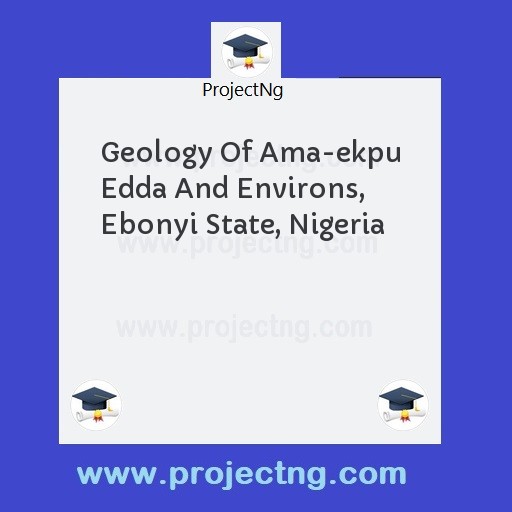Geology Of Ama-ekpu Edda And Environs, Ebonyi State, Nigeria
Geology Project Topics
Get the Complete Project Materials Now! »
ABSTRACT
Ama-Ekpu Edda lies within the Afikpo-Basin, a sedimentary basin set up during the late cretaceous period following the santonian uplift in the southern Benue trough. From the the field study, the Local stratigraphy shows that the lithologic succession consists of black to dark grey shales and sandstone ridges. The sandstones ridge consist of fine to coarse grain that is finining upward. Palynological analysis from the shale samples collected from the surface outcrops in the area yielded a total of 210 palynomorphs, made of 9 pollen species, 5 spore species. The abundance of the pollen species of Longaperites sp, Monosulcites sp, and monocolpites margiriatus, the spore species of cyathides minor, Laerigatosporites sp, along with the dinoflagellate cysts species of leoisphaerida sp, Andallusiclla sp, and senegalium sp, and especially a high abundance of the foraminifera species Bolivina Anambra, suggest a nearly late Campanian to Early Maastrichtian age for the sediments. Based on the distribution of the palynomorph species recovered from the shale samples, the study area has been interpreted as an open marginal marine to estuarine environment at the time of sediment deposition occurring during a period of marine incursion. Hydrogeological investigation of the surface water collected at ufueseni River shows the presence of coliform which probably results from feacal deposits washed down the river through erosion.
Keywords: Shale, Biostratigraphy, Palynology, Palynomorphs.
CHAPTER ONE
INTRODUCTION
Background to the study
The study area Ama-ekpu Edda and its environs comprises of villages in Afikpo South Local Government of Ebonyi State. Communities within the studied area include; Achara, Amancho, Amangwu, Asaga, Amoba, Okpocha, Ekoli, Ebunwana, Ugwufiere, Ufueseni, Owutu, Ekeje, Letu, and Nguzu-Edda. This project work tends to evaluate the fundamental factors influencing the properties of cohesive soils within the study. These cohesive soils were largely found in Ama-ekpu Edda and nearby villages around. The study area, Ama-ekpu Edda, lies entirely in the Afikpo Sub-Basin, a depression set up subsequently with the Anambra Basin after the epierogenic event which folded and uplifted the Albian-Cenomanian sediments into the Abakiliki Anticlinorium. The Afikpo Sub-Basin is a coeval basin with the Anambra basin, both lying unconformably on the Santonian sediments of the Benue Trough, even though recent studies have revealed that pre-Santonian sediments occur within the basin. Sediments making up this basin include those deposited in the second depositional cycle from the Campanian to Maastrichtian. The study area is underlain entirely by the Nkporo formation, the basal lithostratigraphic unit of the Afikpo Sub-Basin. This formation as observed in the study area comprises of grey to black coloured fine-medium sandstone lenses. The shale underlying the study area has high organic content and gypsum. The gypsum occurring in the sediments are diagenetic minerals occurring as scattered streaks in the beds. It has been acclaimed for its highly fossiliferous nature of the shale, this work incorporates data from both palynological biostratigraphy and the more conventional foraminifera biostratigraphy, as tools in acquiring the age and depositional history of the sediments, providing thus, unbiased information. The lithological and microfaunal association of the Nkporo formation suggests a restricted shallow marine environment. A normal marine origin has however been suggested for the Asaga-Amangwu shale based on palynological evidences as obtained from palynological analysis, as well as a marginal to marine for the Nkporo formation, assigned a Maastrichtian age for the sediments of this formation based on mollusces and fish teeth from Asaga-Amangwu and Nkporo village suggesting an early Maastrichtian age for the sediments following an integrated study of foraminifera and palynomorphs; whereas, a late Campanian age was assigned to these sediments in from palynological analysis alone. While much of these works were obtained from regional studies, this work studies particularly the microfaunal association of the study area.
1.1 Aims and Objectives
- To make a detailed description of the different rock types encountered.
- To study the Geology and fossil analysis of Ama-ekpu Edda and use it to determine the age relationship between the lithologies encountered in the environment of deposition.
- To make a detailed study of the economic minerals potential of the area.
- To discuss the geology of the area, the lithofacies units, interpret and analyze the fossil assemblage encountered in the study area, and interpret the depositional environment.
- Constructing a geologic map of the study area.
1.1.2Significance of the Study
Why we went to the field is to add or support the knowledge to the existing knowledge of the area.
3. Location, Extent and Accessibilty
The study area Ama-Ekpu Edda is located at Afikpo south local Government Area of Ebonyi state in south Eastern Nigeria. The extent of study or mapped area is bounded on the North and south by latitudes 5º50’N and 5º55’N of the equator and on west and east by longitudes 7º50’E and 7º55’E of the Greenwich Meridian respectively Fig.1 is the accessibility map of the study area.
Be the First to Share On Social

Enjoying our content?
Don't miss out on new videos! Subscribe to our YouTube channel for more awesome content.
Subscribe Now!













